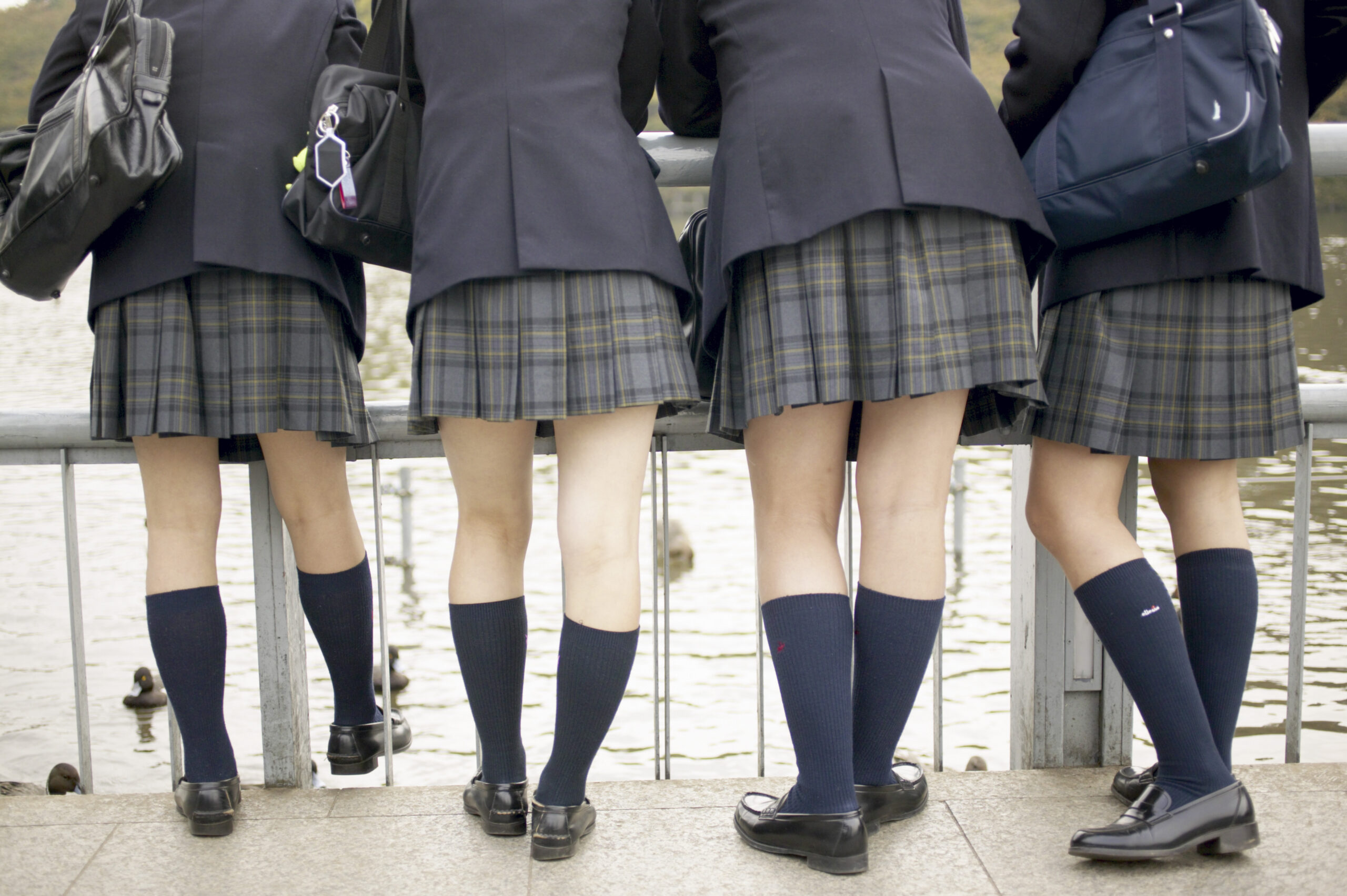Choice of short skirts for female students, even during the cold winter months. Some female students choose to wear their skirts shorter as a form of self-expression and personal style.

Introduction
In Japan, it is a common sight to see female students wearing short skirts even during the cold winter months. This fashion choice may seem perplexing to those unfamiliar with Japanese culture and weather conditions. In this article, we will explore the reasons behind this phenomenon, examining the cultural, practical, and psychological factors that contribute to Japanese female students’ choice of clothing.
Japanese school uniforms hold significant cultural value and are deeply ingrained in the country’s educational system. The uniformity of dress promotes a sense of equality among students and instills a spirit of discipline and conformity. However, the question arises: Why do Japanese female students continue to wear short skirts in winter, despite the low temperatures?
Cultural Significance of School Uniforms in Japan
To understand why Japanese female students wear short skirts in winter, we must first recognize the cultural significance of school uniforms in Japan. School uniforms play a crucial role in Japanese society, symbolizing discipline, conformity, and unity among students. These uniforms create a sense of belonging and foster a collective identity among students.
The tradition of school uniforms in Japan can be traced back to the late 19th century. Uniforms not only create a sense of identity but also foster a feeling of belonging to a particular institution. The adherence to uniform guidelines is highly valued, and it reflects the respect for rules and authority within Japanese society.
The Evolution of the Sailor Uniform
The iconic sailor-style school uniform, known as “sailor fuku,” is widely recognized in Japan. This uniform design originated from the British Royal Navy uniforms and was introduced to Japanese schools in the late 19th century. The sailor fuku is characterized by its high-collared blouse, pleated skirt, and sailor-style collar with a necktie or bow.
Historical Origins and Influence
During the Meiji period in Japan (1868-1912), there was a significant shift in the education system, with the government emphasizing the importance of universal education. As part of this educational reform, academy uniforms were introduced to promote equivalency among scholars, anyhow of their socioeconomic backgrounds. The sailor fuku became a symbol of modernization and progress.
The Influence of Pop Culture
Japanese popular culture, including manga, anime, and J-pop, has had a profound impact on fashion trends in the country. Many manga and anime series depict female characters wearing school uniforms, often with shorter skirts. These depictions have contributed to the popularization of the short skirt trend among Japanese female students.
Fashion and Individuality
Despite the traditional and conservative nature of school uniforms, Japanese students often find ways to express their individuality within the boundaries of the uniform guidelines. Some female students choose to wear their skirts shorter as a form of self-expression and personal style. This act of individualism allows them to stand out while still adhering to the overall uniform code.
Weather conditions in winter
Japan experiences varying winter climates across its regions, ranging from mild temperatures in the southern parts to chilly and snowy conditions in the northern areas. Despite the cold weather, most schools in Japan do not have centralized heating systems in classrooms. Students rely on individual heaters or warm clothing to keep themselves comfortable.
While it may seem counterintuitive to wear short skirts in winter, Japanese students have developed practical ways to adapt to the cold weather. Layering is a common practice, with students wearing thermal leggings or stockings underneath their skirts to keep warm. Additionally, knee-high socks and boots are often paired with the uniform to provide further insulation.
Social pressure and fashion trends
The perception of femininity and societal expectations in Japan also contribute to the prevalence of short skirts among female students. In Japanese culture, there is an emphasis on modesty and femininity, and shorter skirts are often associated with these qualities. By adhering to these expectations, female students can align themselves with traditional gender norms.
Japanese street fashion has gained significant popularity worldwide. Harajuku, a district in Tokyo, is renowned for its unique fashion subcultures that have influenced global trends. The emphasis on personal style and self-expression has permeated Japanese society, and young people often prioritize fashion choices over practical considerations.
Cultural and Generational Shifts
It is important to note that fashion trends are not static and evolve over time. While the short skirt trend remains prevalent, there has been a gradual shift towards longer skirt lengths in recent years. This change reflects the influence of changing societal attitudes and the desire for more modest fashion choices among the younger generation.
In conclusion, the phenomenon of Japanese female students wearing short skirts in winter is a complex blend of cultural, historical, social, and individual factors. School uniforms, influenced by historical origins and popular culture, play a significant role in shaping this trend. The adaptability of students to the weather, coupled with the desire for self-expression and adherence to societal norms, further contributes to the widespread adoption of this fashion style.
Practical considerations
Japanese students have developed strategies to cope with the winter chill while adhering to fashion trends. Layering is a common technique, where thermal undergarments and leggings are worn beneath the skirts to provide insulation. Students also accessorize with warm socks, boots, and scarves to add both style and warmth to their outfits.
Psychological factors
For many Japanese students, their school uniform is an integral part of their identity. It represents their affiliation with a specific school and creates a sense of belonging to a larger community. Peer pressure and group dynamics also play a role in the decision to wear short skirts in winter, as conformity to the established norms is often seen as essential for social acceptance.
Impact on body image and self-esteem
The pressure to conform to societal beauty standards is prevalent in many cultures, and Japan is no exception. In Japanese culture, femininity is often associated with modesty, grace, and purity. Wearing a short skirt in winter may be seen as a display of femininity, leading to enhanced self-esteem and a sense of empowerment for some students.
Criticisms and controversies
The practice of wearing short skirts in winter has faced criticism and controversy. Some argue that it objectifies and sexualizes young girls, as the exposed legs may attract unwanted attention. Discussions on gender equality and empowerment have also questioned the enforcement of different dress codes for male and female students.
Conclusion
The choice of Japanese female students to wear short skirts in winter is influenced by a combination of cultural, practical, and psychological factors. While tradition and societal expectations play a role, personal style and the desire for self-expression also contribute to this fashion trend. It is important to consider the individual choices and motivations of students while engaging in discussions around dress codes and societal norms.
FAQs
Q1: Are school uniforms mandatory in Japan?
A1: Yes, school uniforms are mandatory in most Japanese schools as they promote a sense of unity and equality among students.
Q2: Do male students in Japan also wear short skirts in winter?
A2: No, the practice of wearing short skirts in winter is primarily associated with female students in Japan.
Q3: Are there any regulations regarding school uniform lengths in Japan?
A3: While some schools may have guidelines for uniform lengths, the implementation and enforcement may vary.
Q4: Are there any alternative options for female students who prefer warmer clothing in winter?
A4: Some schools may provide alternative uniform options, such as longer skirts or pants, for female students during colder months.
Q5: How do Japanese students manage to stay warm despite wearing short skirts in winter?
A5: Japanese students often utilize layering techniques, wear thermal undergarments, and accessorize with warm socks, boots, and scarves to stay warm in winter.

